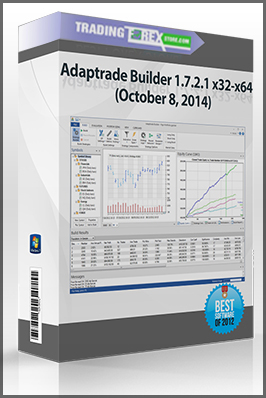SmartFolio 3.2.4 Individual License
Original price was: $599.00.$65.00Current price is: $65.00.
Sales Page Price: $599
You Just Pay : $65
Contact us
- Description
Description
SmartFolio 3.2.4 Individual License
Sales Page : smartfolio.com
Files of Product : http://imgur.com/vIcqvmf
SmartFolio will help you solve a variety of practical tasks including:
 |
Find the most appropriate asset allocation according to your investment goals, market history andforecasts; |
 |
Analyze risks of your investment portfolio from various perspectives (volatility, value-at-risk,shortfall probabilities); |
 |
Arrive at adequate portfolio rebalancing strategy to minimize rebalancing transaction costs. |
Supported analytical methods include shrinkage estimators, robust portfolio optimization, walk-forward portfolio optimization,benchmark tracking, Black-Litterman model, factor models, and many others.
Features
Our advanced, constantly updated software gives the investor all the tools they need. Some of the mathematical algorithms utilized by SmartFolio have only emerged in the last few years. Many are therefore not to be found in other commercial products. The most important SmartFolio features are outlined below:
 |
Fully supports the multi-period investment paradigm. |
 |
Fully supports portfolios featuring assets with non-Gaussian distribution of returns, or non-linear inter-dependencies, including options and hedge funds. This is achieved through direct simulation of portfolio dynamics with no model assumptions. |
Portfolio Construction
 |
Simultaneous creation of two environments for portfolio analysis:
|
 |
Risk-free asset option. |
 |
Factor-selection option for a factor-based asset pricing model. |
Estimation of parameters
 |
Equally-weighted sample estimates of expected returns and covariances |
 |
Exponentially weighted sample estimates of expected returns and covariances (new in v.3.1) |
 |
Stambaugh combined-sample estimates, used if asset histories differ in length. |
 |
Jorion expected returns estimate, which shrinks sample average returns to a common value. |
 |
Ledoit-Wolf covariance matrix estimate, which shrinks the sample covariance matrix to the constant correlations covariance matrix. |
 |
Pastor-Stambaugh-Wang joint estimate of expected returns and covariances, which shrinks sample estimates to their respective counterparts, implied by the selected factor model. |
 |
MacKinlay-Pastor joint estimate of expected returns and covariances, based on the assumption that prices are explained by an unobservable factor. |
 |
The Black-Litterman model that incorporates subjective invetsor views in parameter estimation and asset allocation process. |
 |
Dummy estimates of expected returns and covariances further used in construction of risk-based portfolio strategies (risk parity and maximum diversification) (new in v.3.2) |
Portfolio optimization
 |
Four optimization criteria: |
- Maximization of an expected utility with constant relative risk aversion
- Minimization of target shortfall probability
- Benchmark tracking ( = volatility minimization relative to any benchmark asset)
- Maximizaton of instantaneous Sharpe ratio (utilized in construction of risk-based portfolio strategies) (new in v.3.2)
 Robust portfolio optimization(worst-case scenario optimization): the resultant portfolios demonstrate optimal behavior under the worst-case scenario.
Robust portfolio optimization(worst-case scenario optimization): the resultant portfolios demonstrate optimal behavior under the worst-case scenario.  Walk-forward optimization:
Walk-forward optimization:
- Arbitrary lengths of in-sample and out-of-sample windows
- Choice between rolling and expanding in-sample window (new in v.3.1)
 Optimization engine based on IPOPT (Internal Point OPTimizer) — one of the most powerful nonlinear optimizers available.
Optimization engine based on IPOPT (Internal Point OPTimizer) — one of the most powerful nonlinear optimizers available.
Target shortfall probabilities analysis
 |
Calculation of target shortfall probabilities according to selected ranges for the investment horizon and target rate. |
Value-at-Risk analysis
 |
Simultaneous calculation of two risk measures: Value-at-Risk (VaR) and Conditional Value-at-Risk(CVaR). |
 |
Various techniques for calculation of VaR and CVaR, including:
|
 |
Construction of VaR and CVaR surfaces according to selected ranges for the investment horizon and significance level. |
Historical simulations
 |
Simulations of portfolio strategies with continuous rebalancing. |
 |
Simulations of portfolio strategies with continuous rebalancing and portfolio insurance — these strategies are optimal in a situation when a predetermined portion of the initial wealth and/or accumulated profits must be maintained. |
 |
Portfolio-strategy simulations with “inaction region” rebalancing — these strategies are optimal in the presence of proportional transaction costs. |
 |
Portfolio-strategy simulations with “inaction region” rebalancing and portfolio insurance. |
Data management
 |
Choose either an Access-database or Excel spreadsheet format to store your data. |
 |
Several historical data sources:
|
 |
Batch import from all data sources |
 |
1-click update from all data sources |
Miscelaneous
 |
“Three-fund” portfolio calculation — utility-based portfolio, optimal in the presence of anestimation error in the model parameters. |
 |
Utilization of Block Bootstrapping algorithm in the calculation of VaR, CVaR, and shortfall probabilities. |
 |
Determine Inaction region optimal size in the presence of proportional transaction costs, based on a multidimensional extension of the Davis-Norman approach. |
 |
Wide range of optimization constraints, which also include:
|
 |
Various performance measures including Information ratio, Sortino ratio and STARR ratio. |















